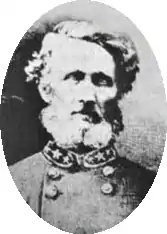27th Texas Cavalry Regiment
The 27th Texas Cavalry Regiment, at times also known as Whitfield's Legion or 1st Texas Legion or 4th Texas Cavalry Battalion, was a unit of mounted volunteers that fought in the Confederate States Army during the American Civil War. First organized as the 4th Texas Cavalry Battalion or the 1st Texas Legion, the unit fought at Pea Ridge, First Corinth, Iuka, and Second Corinth. Additional companies from Texas were added and the unit was upgraded to a regiment in late 1862. The 27th Texas Cavalry fought at Holly Springs in 1862, Thompson's Station in 1863, and in the Atlanta campaign, Franklin, and Nashville in 1864. The regiment surrendered to Federal forces in May 1865 and its remaining soldiers were paroled.
| 27th Texas Cavalry Regiment Whitfield's Legion 1st Texas Legion 4th Texas Cavalry Battalion | |
|---|---|
 John Wilkins Whitfield was the first colonel. | |
| Active | March 1862 – 4 May 1865 |
| Country | |
| Allegiance | |
| Branch | |
| Type | Cavalry and Infantry |
| Size | Battalion, then Regiment |
| Nickname(s) | Whitfield's Legion, 1st Texas Legion, 4th Texas Cavalry Battalion |
| Engagements |
|
| Commanders | |
| Notable commanders | Col. John Wilkins Whitfield |
Corinth
At the Second Battle of Corinth on 3–4 October 1862, the 1st Texas Legion (dismounted) was part of W. Bruce Colbert's brigade, Louis Hébert's division, Sterling Price's corps.[1] On 3 October, Colbert's brigade was in reserve behind Hebert's three frontline brigades during the mid-morning attack,[2] and it was still in reserve at 3:30 pm.[3] On 4 October, Van Dorn expected Hébert's division to attack at dawn, as ordered. However, Hébert belatedly reported himself sick at headquarters and was replaced by Martin E. Green.[4] In the confusion, Green's division did not attack until 10:00 am.[5] Green's two right-hand brigades burst through the Union defenders and seized Battery Powell, but took heavy losses.[6] The two left-hand brigades, which included Colbert's, ran into tougher opposition. After 45 minutes of fighting, Colbert's soldiers were repulsed with serious losses. The Union troops captured 132 men from Colbert's brigade.[7] At Corinth, the 1st Texas Legion lost 3 killed, 17 wounded, and 75 captured.[8]
Notes
- Cozzens 1997, p. 327.
- Cozzens 1997, p. 167.
- Cozzens 1997, p. 203.
- Cozzens 1997, p. 235.
- Cozzens 1997, p. 237.
- Cozzens 1997, pp. 240–245.
- Cozzens 1997, pp. 250–251.
- Official Records 1886, p. 382.
References
- "The Battle of Thompson's Station". American Battlefield Trust. 2017.
- Battles and Leaders of the Civil War. 4. Secaucus, N.J.: Castle. 1987 [1883]. ISBN 0-89009-572-8.
- Benner, Judith Ann: ROSS'S BRIGADE, C.S.A. from the Handbook of Texas Online (June 22, 2017). Retrieved March 16, 2020.
- Boatner, Mark M. III (1959). The Civil War Dictionary. New York, N.Y.: David McKay Company Inc. ISBN 0-679-50013-8.CS1 maint: ref=harv (link)
- Cozzens, Peter (1997). The Darkest Days of the War: The Battles of Iuka and Corinth. Chapel Hill, N.C.: University of North Carolina Press. ISBN 0-8078-2320-1.CS1 maint: ref=harv (link)
- Cutrer, Thomas W.: WHITFIELD'S LEGION from the Handbook of Texas Online (March 8, 2011). Retrieved March 17, 2020.
- Hathcock, James A.: TWENTY-SEVENTH TEXAS CAVALRY from the Handbook of Texas Online (April 7, 2011). Retrieved March 17, 2020.
- Shea, William L.; Hess, Earl J. (1992). Pea Ridge: Civil War Campaign in the West. Chapel Hill, N.C.: The University of North Carolina Press. ISBN 0-8078-4669-4.CS1 maint: ref=harv (link)
- "Thompson's Station". National Park Service. 2017b.
- War of the Rebellion: A Compilation of the Official Records of the Union and Confederate Armies Volume XVII Part I. Washington, DC: Government Printing Office. 1886. p. 382. Retrieved January 22, 2021.
- "The War of the Rebellion: A Compilation of Official Records of the Union and Confederate Armies, Chapter XXXVI". Washington, D.C.: United States War Dept. 1889. Retrieved June 18, 2020.